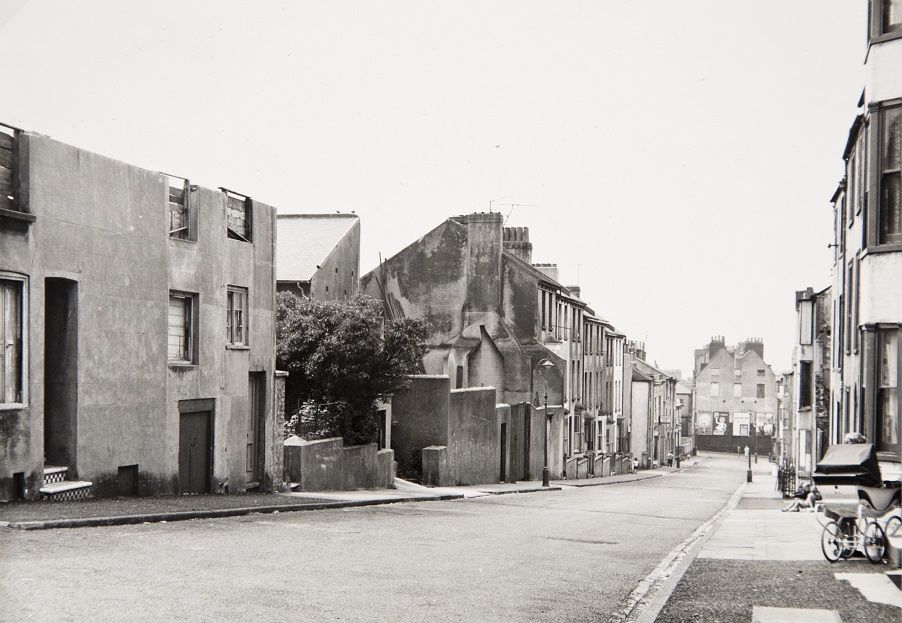
A nineteenth-century street part-demolished in the 1970s during Brighton’s slum clearance is being restored as part of a modern development.
Only a small section of Mighell Street, behind the Amex offices, still exists with just a handful of buildings surviving, including a Grade II listed flint farmhouse.
But with the development of the Edward Street Quarter on the site of the old Amex building, the street is once again being opened up from Carlton Hill to Edward Street.
Developer First Base is also creating a new gateway and has asked artists for submissions for its design, with a winner to be announced on March 5.
Steve Eccles, Project Director at First Base, said: “We’re so excited about this sculptural gateway and about restoring the lost part of Mighell Street which was once part of the fabric of Victorian Brighton.
“It’s very important for new developments to have a sense of place about them and to have links with the local area.
“We hope that restoring memories of Mighell Street will bring joy to local residents.
“Apart from two listed buildings, the rest of Mighell Street was demolished in the 1970s, so it’s great to see this thoroughfare make a comeback and to celebrate its return with a sculptural gateway.”
Mighell Street was formerly known as Richmond Road. It was named after Philip Mighell, who was a local landowner at the end of the 18th century.
The public art gateway is one of two areas designated for public art at Edward Street Quarter, based on the site of the former Amex House. The re-opened Mighell Street will join Edward Street and Carlton Hill.
For more information, please visit edwardstreetquarter.com.

History of Mighell Street
Most of the houses demolished in the 1970s were built in the early nineteenth century, when the street was named after Regency property owner Philip Mighell.
A few original buildings still survive in the remaining stub of Mighell Street. Numbers 34-35 are Grade II listed and were supposedly a former farmhouse built in the early 19th century according to Historic England. They are now divided into two homes.
In 1845, a number of artisan trades people lived on the street, including Robert Hunter, a boot and shoemaker who lived at number 2, Mrs Ann Kent at number 18 was a beer retailer and at 34 was Thomas Blockley, a grainer and sign writer.
There were several dressmakers, a timber merchant and coach maker, as well as two schools. These people would have provided services to the wealthy residents living nearer to the Royal Pavilion.
The Carlton Hill area was known for its fishing community, colloquially called the ‘fisher-folk’, who lived in the area and used its workshops and warehouses to cure and smoke their herring catches.
A contemporary writer, quoted by Brighton historian Clifford Musgrave, observed that “an aromatic and appetising pall would envelop the entire neighbourhood, kippering both fish and residents alike”.
Fast forward to 1850 and Mighell Street had a dairy at number 10 run by Mr G Deacon. Before refrigeration dairies were often found in city centres so give residents access to fresh milk.
The street also housed a coach builder, cabinet maker, watch maker and the timber merchant, while the rest of the road accommodated small tenements.
A Strict Baptist Chapel was built here in 1878, known as Mighell Street Hall. It was compulsorily purchased and demolished in 1961.
Around the 1880s Carlton Hill was known as Brighton’s ‘foreign quarter’, where many Italian and French street vendors, who sold various types of food around Brighton, lived.
By the 1930s there were only three businesses on the west side of the street. Zoe Brigden ran a ladies’ hairdresser and William Brigden worked as an undertaker, sharing space at number 2.
Chimney sweep Alfred Hill lived at number 12 and on the opposite side of the road George Lynn & Sons builders could be found at number 35. The rest of the street was mainly residential.
Carlton Hill was historically a very poor area and was a victim of slum clearances throughout the 20th century, which meant the destruction of many of the area’s historic buildings.
In the final days of Mighell Street before its demolition, George Lynn & Sons builders survived into the 1960s by which time there was a pub called the Black Lion at number 47 which was next door to Nielsens Ice Cream and Frozen Foods.








Hi all the picture of Mighell street was a sight for sore eyes it brought back a lot of memory’s we lived at 39 and I remember having a pop gun that fired corks and I used to hit tin cans in the back yard by the side of the outside toilet where the tin bath was hanging I also kept pigeons and played with my tin soldiers
Such nice memory’s
There was no game boy then or iPods
My G.G.G.Grandmother, Mary Walder, died in Mighell Street in January 1844 aged 73.
I beleive she owned No25 as her Will states;-
Freehold messuage, no 25 of Mighell Street, in Brighton, lately purchased under the will of
the late Cornelius Shvrell
Proved at Lewes, 12 March 1844, reciting death of testatrix, 20 January 1844
I am still researching this family for my Ancestry.